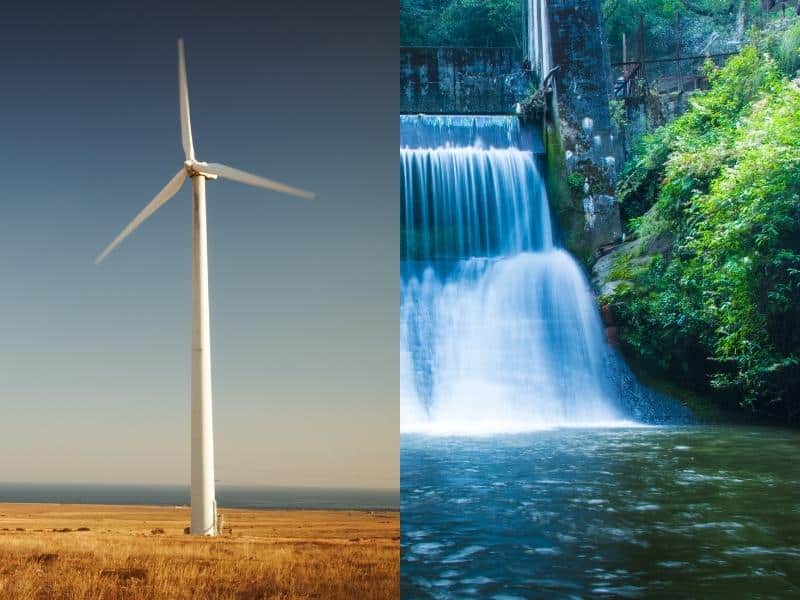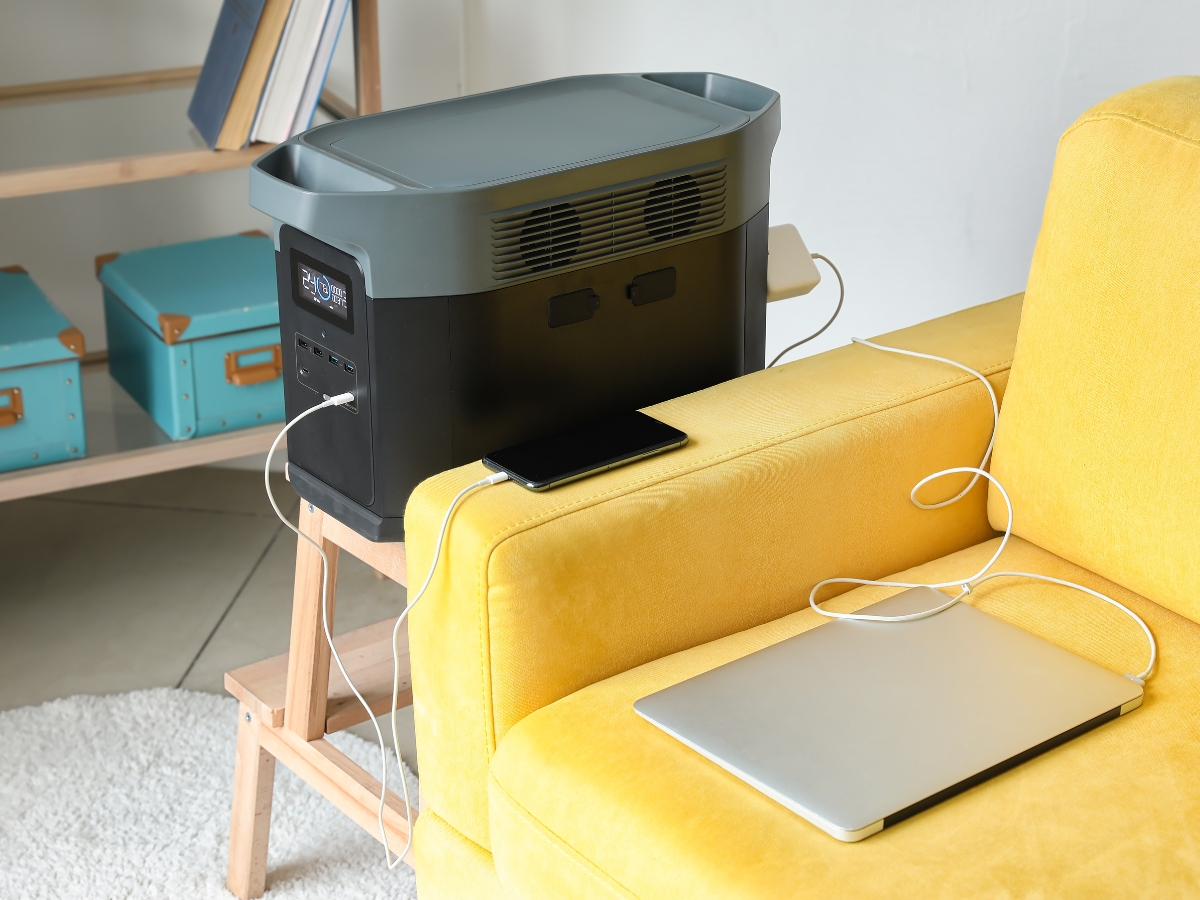Alternative energy is all the rage as the world transitions away from fossil fuels like oil and coal in favor of more eco-friendly options such as hydropower and wind power.
These two forms of energy are different in some respects but share common characteristics, which we’ll focus on here.
Here are the main points we’ll cover:
- What hydropower is
- What windpower is
- Common factors with hydro and wind power
You’ll be surprised to learn just how much hydropower and wind power have in common. Let’s get it into it.

What is hydropower?
Hydropower borrows the energy from flowing water and transforms it into mechanical energy, which can in turn be used to generate electricity.
Through the water cycle, water can generate power. Here is a brief summary of how it works:
- Energy from the sun (solar) heats up the water on ocean, lake, and river surfaces. This triggers the evaporation of water (turning the water from liquid into gas).
- The gaseous water (called water vapor) travels from the surface of the water bodies into the air, where it forms clouds. It then falls back to Earth in the form of snow, hail, or rain.
- The water that falls back to earth (called precipitation) reconvenes in the streams and rivers it originally came from. These bodies dump water, in turn, into lakes and oceans, where the cycle begins anew.
In this way, water perpetually stays in motion – a motion that crafty scientists can take advantage of to turn into useful energy for multiple human purposes, including powering homes and businesses.
A brief history of hydropower
The use of hydropower is lengthy, dating back as far as 200 B.C. in ancient China during the Han dynasty.
Although it didn’t generate electricity, the mechanical energy in these primitive devices was utilized to de-shell grain and make paper.
The development of the modern iterations of hydropower accelerated around the 1800s as European and then American inventors began to experiment with new designs.
By the end of the 19th century, hydroelectric (meaning hydropower converted into electricity) plants had opened across Europe and North America for commercial purposes.
The Edward Dean Adams Power Plant – at the time the largest hydroelectric project in history – opened in Niagara Falls in 1895.
What is wind power?
As hydropower relies on moving water to generate energy, wind power relies on moving air. Historically, wind power has been used, like hydropower, to separate the wheat from the chaff (grain processing) and to perform other similar tasks.
The most iconic tool to generate wind power is the windmill. Conventionally made of four turbines (“wings”) the wind that naturally blows across the land forces the turbines to rotate in a circle.
That energy is then captured as mechanical energy. In the same type of process used in hydropower, that mechanical energy then morphs into electrical energy.
A brief history of wind power
Wind power is even older than hydropower. Its use by humans stretches as far back into history as 5,000 B.C. when boatmen used wind to propel their crafts over the Nile River in Africa.
Seafaring people throughout the world adopted this technology and used it to explore the world. Around 200 B.C., the Chinese had adopted wind power to pump water in primitive machines. In Persia and elsewhere, windmills ground grain.
In the early American days, when it was still a colony of Great Britain, the use of windmills became widespread. Eventually, beginning in the early 20th century, electrical liens reached the rural expanses of the country and their use dwindled.
Now, though, thanks to the “Green Revolution,” wind power is coming back into fashion with a vengeance.
Similarity #1: Wind power and hydropower use similar processes
As we described the process of generating power from water and wind, respectively, you may have noticed some common themes. One of these is that each uses a similar logic that goes something like this:
- The kinetic energy from a natural resource is captured through technology
- Kinetic energy shifts into mechanical energy
- Mechanical energy can then be transformed into electrical energy for commercial use
Similarity #2: Water and wind are both abundant resources
If you watched Captain Planet as a kid, you’ll remember that wind and water were two of the five elements used to summon him.
Like solar power which harnesses the energy from the sun, wind and water are hugely abundant on Earth – which makes them ideal for use as renewable energy.
This is in contrast to fossil fuels like petroleum and coal, which are finite resources that also require extensive effort to extract from deep within the Earth. Water and wind are available right outside your window.
All that is required to utilize them is efficient technology – which is rapidly developing.
Similarity #3: Hydropower and wind power each leave no carbon footprint
The major problem with fossil fuels, and the reason that we must transition away from their widespread use, is that, through the combustion process, they release carbon dioxide into the atmosphere as a chemical byproduct.
Over time, the accumulated carbon dioxide in the atmosphere leads to numerous environmental problems, including unhealthy changes to global temperatures.
This is known as the “greenhouse effect.” The cascade of adverse effects has just begun to manifest, and even modern scientists have difficulty predicting the extent of the fallout.
The benefit of hydropower and wind power as alternatives is that they do not leave a carbon footprint as the creation of carbon dioxide as a byproduct is not a feature of their process.
Similarity #4: Wind power and hydropower are each high on the priority list for climate change activists and world leaders
The most generous estimate is that, as a planet, we have 12 years to eliminate our global reliance on fossil fuels or risk environmental catastrophe. In reality, that deadline – in the estimation of many noted researchers – is coming much closer.
This has left world leaders and activists serious about preventing the worst outcomes of climate change scrambling to come up with solutions. The ideal strategy, then, is an “all hands on deck” approach in which every feasible alternative to fossil fuels is explored at maximum speed.
But replacing fossil fuels is easier said than done. Global economies depend heavily on energy as the life source of economic development.
Accordingly, many leaders see the climate change issue as an unsolvable dilemma between much-needed economic development (especially in poorer countries) and protecting the environment.
Solving this dilemma depends on developing cheap methods to use widely available resources to replace the energy that will be lost when fossil fuels are abandoned altogether.
That’s where wind power and hydropower come into play. In addition to solar power, wind and hydropower represent three of the most promising options to match or exceed the energy production capacity of fossil fuels because they are so abundant.
Governments, NGOs, and scientists have come together to invest significant financial and human resources into improving these two forms of power so that they become truly viable alternatives to fossil fuels.
Once the world understands their potential as truly cost-effective replacements, we can make one more step toward saving the planet from disaster.
Sources
https://www.eia.gov/energyexplained/hydropower/
https://www.hydropower.org/iha/discover-history-of-hydropower
https://windexchange.energy.gov/what-is-wind
https://www.eia.gov/energyexplained/wind/history-of-wind-power.php
https://www.livescience.com/12-years-to-stop-climate-change.html



